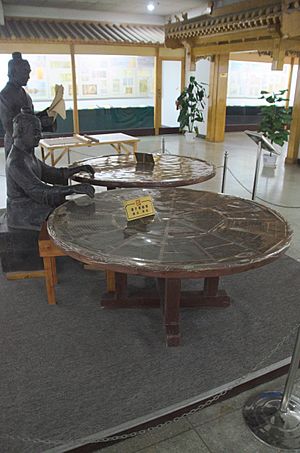Bi Sheng facts for kids
Quick facts for kids Bi Sheng |
|||||||||||||
|---|---|---|---|---|---|---|---|---|---|---|---|---|---|
| Traditional Chinese | 畢昇 | ||||||||||||
| Simplified Chinese | 毕昇 | ||||||||||||
|
|||||||||||||
Bi Sheng (Chinese: 畢昇; 972–1051 AD) was a clever Chinese artisan, engineer, and inventor. He created the world's first movable type technology. This invention was a huge step forward for printing, which is one of China's famous Four Great Inventions. Bi Sheng's system used Chinese porcelain (a type of ceramic). He developed it between 1039 and 1048, during the Song Dynasty.
Contents
How Movable Type Printing Worked
Bi Sheng was born in Yingshan County, Hubei. He was an ordinary person, so not many details about his life were written down. We know about his invention thanks to a book called Dream Pool Essays. This book was written by a Chinese scholar named Shen Kuo (1031–1095). Shen Kuo's book gives us a detailed look at how Bi Sheng's movable type printing worked.
Making the Type Blocks
Bi Sheng's method was very smart. He started with sticky clay. He would cut individual characters into this clay. Each character was very thin, like the edge of a coin. These cut characters became single pieces of "type." After shaping them, he baked them in a fire. This made the clay characters hard and durable.
Setting Up for Printing
To print, Bi Sheng first prepared an iron plate. He covered this plate with a special mixture. This mixture was made of pine resin, wax, and paper ashes. When he wanted to print a page, he would place an iron frame on this prepared iron plate. Then, he would carefully arrange his hard clay type blocks inside the frame. He placed them very close together to form the words and sentences for the page.
Printing the Page
Once the frame was full of type blocks, it became one solid block of text. He would then warm this block near a fire. This made the paste (the resin, wax, and ash mixture) on the iron plate melt a little. After it melted slightly, he would take a smooth board. He pressed this board firmly over the surface of the type blocks. This made sure all the type blocks were perfectly even, like a smooth stone. This even surface was important for clear printing.
Organizing the Characters
Bi Sheng was very organized. For each character, he made several type blocks. For common characters, he even made twenty or more! This was so he could print pages that had the same character many times. When the characters were not being used, he kept them neatly arranged. He used paper labels for each group of characters that sounded alike. He stored all these type blocks in wooden cases.
Later Improvements
Later, another government official named Wang Zhen (who lived around 1290–1333) improved Bi Sheng's clay types. Wang Zhen used wood instead of clay. His method made setting up the type even faster. Much later, around 1490, a rich printer named Hua Sui (1439–1513) developed movable type made of bronze in China.
Legacy
Bi Sheng's invention left a lasting mark. A place called Bisheng Subdistrict (畢昇社區) in Wenquan, Huanggang, Hubei, is named after him. Even on the far side of the Moon, there's a crater named Bi Sheng! The IAU officially named this crater in August 2010.
See also
 In Spanish: Bi Sheng para niños
In Spanish: Bi Sheng para niños


